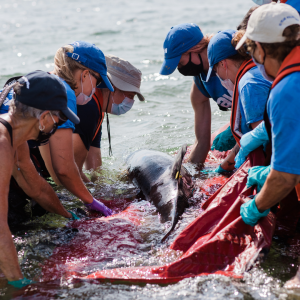WHAT YOU SHOULD KNOW ABOUT RELEASING AND REHABILITATING INJURED DOLPHINS

According to the World Wildlife Federation, climate change is quickly becoming the biggest threat to bottle nose and Atlantic spotted dolphins, the species most often seen along the Emerald Coast. Changing sea temperature, the freshening of sea water from melting ice, increase rainfall, and decreased krill are all effects of climate change and are making the dolphin’s home less hospitable. Humans continue to both literally and figuratively “trash” the ocean, as every ocean in the world is littered with man-made debris, from sandwich bags to six pack holders, to discarded fishing nets and lines. Dolphins, along with other marine life often accidentally eat this trash, which causes internal injuries, intestinal blockage, and starvation. More than 300,000 dolphins and whales each year are caught in fishing lines and net as “by catch”.
Along Florida’s  Emerald Coast, two organizations, the Emerald Coast Wild life Refuge, and the Gulf World Marine Institute are dedicated to rescuing and rehabilitating marine life, including dolphins. Both organizations are sanctioned by the National Marine Fisheries Service (NMFS) and the Florida Fish and Wildlife Conservation Commission (FWC) as first responders for stranded and injured marine life in our area. Both organizations work to save and safeguard marine life and educate the public about protecting turtles, dolphins, and animals from harm. Along with other scientists, the staff and volunteers at Emerald Coast Wildlife Refuge and Gulf Coast Marine Institute study stranded and beached dolphins to understand why this phenomenon occurs. They work tireless to rehabilitate the animal are release it back into the wild, but many times they are unable to function in the wild. Dolphins must be able to use their sonar, catch live fish, and protect themselves against predators before they can be released. Gulf World Marine Institute is the area’s only long term marine mammal rehab facility. Located in Panama City, GWMI has been providing both long and short term care for marine animals since 1970.
Emerald Coast, two organizations, the Emerald Coast Wild life Refuge, and the Gulf World Marine Institute are dedicated to rescuing and rehabilitating marine life, including dolphins. Both organizations are sanctioned by the National Marine Fisheries Service (NMFS) and the Florida Fish and Wildlife Conservation Commission (FWC) as first responders for stranded and injured marine life in our area. Both organizations work to save and safeguard marine life and educate the public about protecting turtles, dolphins, and animals from harm. Along with other scientists, the staff and volunteers at Emerald Coast Wildlife Refuge and Gulf Coast Marine Institute study stranded and beached dolphins to understand why this phenomenon occurs. They work tireless to rehabilitate the animal are release it back into the wild, but many times they are unable to function in the wild. Dolphins must be able to use their sonar, catch live fish, and protect themselves against predators before they can be released. Gulf World Marine Institute is the area’s only long term marine mammal rehab facility. Located in Panama City, GWMI has been providing both long and short term care for marine animals since 1970.

If you see a stranded dolphin, call either Emerald Coast Wild Life Refuge, GWMI, or text #FWC for help. Do not attempt to move the dolphin, because you could cause further damage. You may need to hold the animal’s head, keep its’ blow hole above the water. Dolphin strand because they are sick or injured, so pushing them back into the water is not helpful. While you may have to hold the animal’s head, keep onlookers at a distance, it may not react well to human “petting”. Keep their skin cool and wet, either by pouring water away from their blowhole or placing wet towels or t-shirts on their back.
As you spend time along the Emerald Coast, you can do your part to keep the dolphins safe and the beaches clean. Remove and properly dispose of all your trash every day. Cut the plastic six pack containers, so dolphins won’t get their noses caught in them. Refrain from releasing balloons at the beach, turtles and dolphins mistake them for jellyfish when they land in the water. Limit your use of single use plastics, such as straws, plates, and water bottles, as more than 8 million tons of trash end up in the oceans every year. Remember, the Gulf of Mexico and the bay are dolphin’s home, and we’re just visiting.
To view dolphins safely and in their native habitat, check out our dolphin cruises and click book now at the top of the screen!
